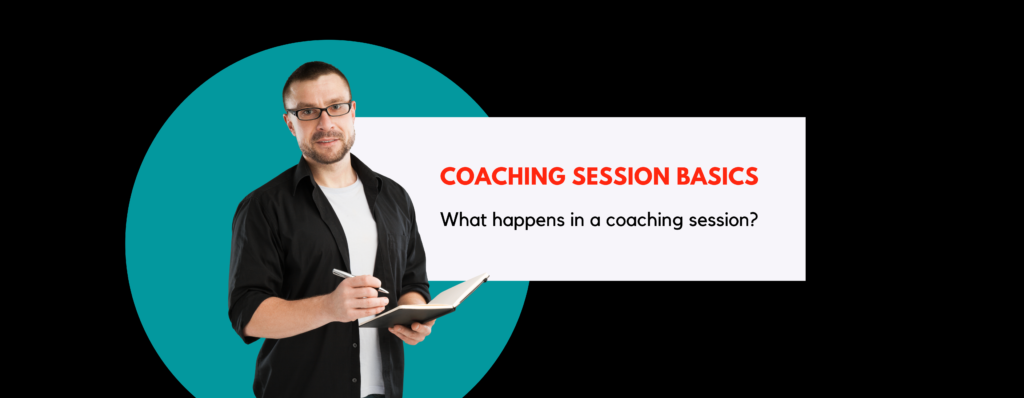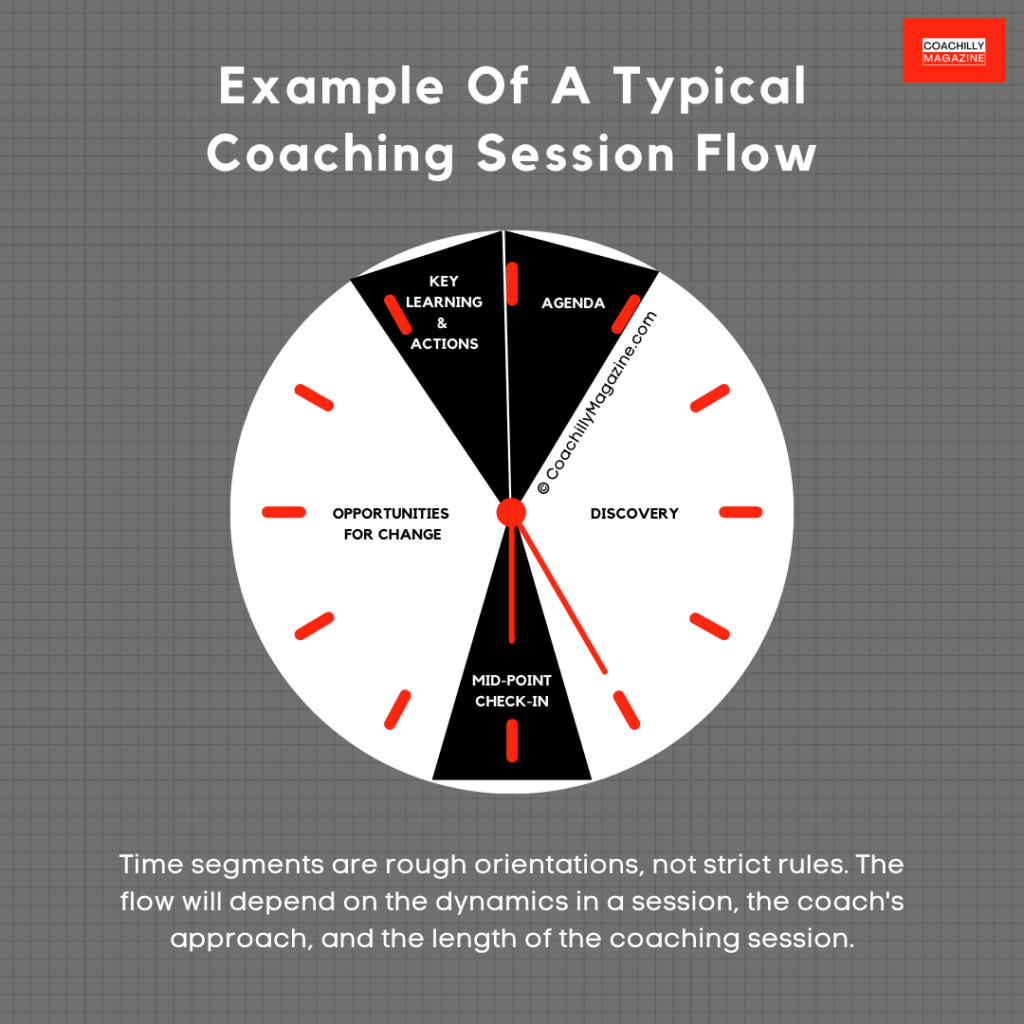
If you wonder what a typical coaching session looks like, this primer about the basics of a coaching session will give you a rundown of what happens before, during, and after a coaching session. You’ll get a coaching session example of the flow of a session as we explain how to run a coaching session. We’ll round this off with some key coaching fundamentals to remember.
This is intended to provide you with an overview of coaching session basics and what typically happens during a session, and important points to consider. It will not replace proper coaching education.
What Happens Before A Coaching Session
Before you coach the client, a few things are required to be prepared. First, you can help the client prepare by thinking through what they want to focus on in your time together. An hour can go by really fast and you won’t solve the world’s problems in 60 minutes (or however short or long your sessions are). You can help your client by sharing prompts that help them prepare. This can be an email with 2-3 questions, a prompt via the coaching platform you are using, or a (short) worksheet or an online session prep form that helps you to speed up the establishment of the coaching agreement. More on that below.
Second, you should review your notes from previous sessions to briefly check in with your client on progress made since your last meeting. This will help you remember what to follow up on before you get into the call. Scrolling through notes to catch up on your last session while you’re on the call with the client will be a distraction to the client.
Lastly, seasoned coaches have learned to self-monitor their physical, emotional, spiritual, and mental states. Doing so allows you to remove all distractions and center your attention fully on the client you serve. For example, if something unpleasant happened to you earlier in the day, you will have to find a way to free yourself from being mentally or emotionally occupied with that unpleasant event – or, if that is not possible, consider rescheduling your session in cases of emergencies that need your full and immediate attention.
The Typical Flow Of A Coaching Session

To understand coaching session basics, we need to talk about the flow of a coaching session. A typical coaching session is divided into key parts that follow coaching fundamentals and the science backing the impact the underlying approaches have in driving successful transformations. Think of a coaching session hour as a pie chart divided into chunks for key things that need to be covered.
To keep this simple, you’ll have a short amount of time, in the beginning, to establish the agenda or focus for the session with the client so you both are aligned on what you will achieve together. This is followed by a larger chunk of time reserved for discovery, another large chunk for ensuring the discovery leads to learning, greater awareness, and clarity and allows you to identify gaps and in the latter part to identify how your client will use these insights to drive actions that move them forward toward their goals. You’ll close the call off by recapping key takeaways and creating accountability and commitment.
Establish The Coaching Agreement First: What’s On The Client’s Agenda?
As you saw earlier, you can help the client prepare for the establishment of their agenda for the coaching session through pre-session prompts. This is not mandatory, but a great helper in getting the most out of the time you’ll spend together as it promotes your client’s thinking about their intention for the call, and the outcome they are expecting from the call.
This is an important core competency for professional coaches. The ICF describes this as the “ability to understand what is required in the specific coaching interaction and to come to an agreement” by “Establishing the agreement for the current session. What is it the client wants to work on today? What will make the next 30 minutes most worthwhile? Establishing a focus.”
Begin The Discovery
Once you have clarity on the coaching topic your client wants to focus on, you will begin to explore with the client. This is the time to ask questions that help the client discover hidden obstacles, underlying beliefs, and perspectives, and to create awareness around “what’s going on” so they can gain the clarity they are looking for.
Help To Harvest Insights, Clarity, And Learning And Identify Gaps
Awareness brings clarity and clarity allows your clients to plan the next steps. So, during your discovery, you will listen for insights, like those “aha moments” and help the client to harvest those insights. What do their discoveries mean for them? How does it inform their behavior, thinking, or decisions? What are they learning about themselves, their environment, or the subject they are exploring? What gaps need to be closed to move forward?
Identify Actions For Change
Toward the latter part of the call, coaches typically help their clients identify meaningful actions that will promote the change they are looking for. This could be the start of a new habit, a conversation they need to have, more reflection on their part, setting time aside to practice, and so many other options. It is important that the client determines what is meaningful to them as it greatly influences their commitment to follow through.
Create Commitment And Accountability
At the end of a typical coaching session, coaches ensure there is a forward movement by checking on the client’s commitment toward the actions you had previously identified. Among all the possibilities you have discussed, what will your client commit to doing between your sessions? How will they stay accountable? What will they do if something wants to get in the way of their commitment, meaning, how will they safeguard their progress?
What Happens After A Coaching Session
What happens after a coaching session largely depends on a coach’s approach. You could decide to follow up a the midway point between your sessions as a quick check-in by email, via chat, or phone. Some coaches use the opportunity to do a pulse check by sending a post-session survey that is very brief and will accomplish two things:
- The coachee briefly repeats one key learning and action they commit to taking.
- The coach receives feedback on how the coaching helped the client and/or what could be improved.
The first part further manifests the learning through repetition and written expression. The second part is important for your service quality and allows you to make adjustments to best serve your client’s needs.
Depending on how you set up your coaching agreement, this may also be your opportunity to remind your client to schedule the next session if they haven’t already done so.
9 Coaching Session Basics To Remember
Here is a brief list of coaching session basics to cover in your coaching sessions:
1 – Establish trust. No trust, no progress. If your client doesn’t trust you, they will not engage in meaningful ways that allow for discovery, accountability, and being challenged to grow, and the dialogue will remain at a surface level. It is your job to create a safe, supportive environment that promotes trust and conveys a safe space to the client. This includes your demonstration of integrity, confidentiality, respect, and support to help your client achieve their goals (not yours).
2 – Establish clarity. Make sure you understand what the client is saying, feeling, and trying to achieve in your session. This involves asking questions and summarizing the answers in the client’s own words.
3 – Leave no stone unturned. Focusing on one area can leave others overlooked. As a coach, you can help to widen the horizon through questions like, “Is there anything else to consider?” or “Do you know enough to move forward on this?”
4 – Adjust to the learning styles and communication styles of your clients. Ask your clients in your discovery call or initial coaching session how they learn and what works best for them. For example, a client might tell you that they prefer examples. Others may share that they prefer candid feedback and being challenged. Take note of it and incorporate it into your coaching.
5 – Listen more than you talk.You are coaching, not teaching. There may be teaching moments, but neuroscience has proven that telling or instructing alone isn’t what moves the needle with humans – it’s allowing the coachee to come to their “aha moment” themselves, with the help of a coach’s leading questions.
The better we listen, the better the questions we ask, and the higher the chances that our coachees will gain insight. Insight is what motivates humans to action, not instruction.
6 – Confirm commitment. A verbal agreement is good, but only useful if your client is committed to taking action toward achieving their goals. During the session, listen for verbal and nonverbal cues.
7 – Ensure accountability. Goals without target dates and actions remain dreams. Make sure you establish an action plan in writing with SMART goals (specific, measurable, actionable, realistic, and time-bound). The client owns the action and the goals, while you as the coach help the client stay on track and make progress.
The linked neuroscience article above also explains how insight motivates us to action, but the motivation lasts only a short time. To change or extend that time, it is important to set actions during the coaching session, toward the end. Ensure that the client writes them down and encourages sharing plans with others (where the topic permits it).
8 – Celebrate and double-check achievements. You may not think this is critical, but achiever-type clients can get so involved in working on the goals that they miss acknowledging their achievements. Other times, you may find that the client marks a tick in the box when in reality, there is still more work to do.
When there is still dissatisfaction, lack of clarity, or hesitation to move forward, you have good indicators that there is more ground to cover. Ask probing questions at the end of each session, to “check the temperature” and see if your client is content with the result of the session or if there is more to work out on the topic.
9 – Upholding ethical standards. In all of your work, whether before, during, or after a coaching session, coaches are required to uphold the ethical standards that guide our industry. While we have no enforcement for many of the ethical standards, breaching them has consequences for your clients, your reputation, and your business. For example, crossing the boundary to therapy when the client needs help from a licensed counselor can have devastating consequences that you are responsible for if you fail to differentiate coaching from counseling so your client understands the difference and if you do not refer your client when it’s clear that they need therapy.
Learn More
- You can watch examples of coaching sessions during events like the annual virtual WBECS summit.
- Subscribe to the ICF (International Coach Federation) YouTube channel to learn more about core competencies for coaches, and more.
- Learn from a highly experienced coach at MCC (Master Certified Coach) level.
- Here’s an example at PCC (Professional Certified Coach) level with an analysis.

